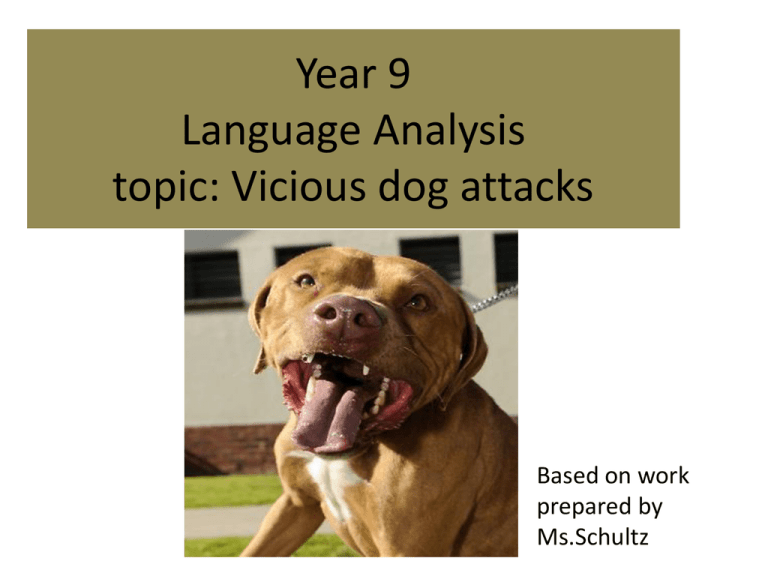Year 9 Language Analysis topic: Vicious dog
advertisement

Year 9 Language Analysis topic: Vicious dog attacks Based on work prepared by Ms.Schultz Last month a tragic event happened in St.Albans where a little girl was killed by a savage dog. There were articles which appeared in the newspapers. In this work we will look at the ways the writers use persuasive techniques in their writing and how this might affect the reader. Background to the issue: On 17th August, 2011 four-year-old Ayen Chol was mauled to death inside her suburban Melbourne home by a neighbour’s escaped pitbull-mastiff cross. The attack renewed calls for the aggressive breed of dog to be banned in Victoria. Victorian Premier Ted Baillieu told the Herald Sun, “There cannot be a more tragic situation that to see a young child like this, in these circumstances, killed in this horrible, horrible way. We don’t want to see this happen ever again and we will do whatever we possibly can to be rid of these dangerous dogs.” On Tuesday, August 30 the Baillieu Government rushed new laws through parliament that will allow Council Officers to seize and destroy unregistered restricted-breed dogs. Owners of pit bulls and pit bull crosses have been given until September 29 to list their dogs on the dangerous dogs register. Dogs on the register must be microchipped, desexed, kept in a secure yard and muzzled and on a lead when in public. American Pit Bull Terrier Association of Australia president Colin Muir said the legislation was misguided. He said, “A breed doesn’t do these things, an individual dog does, and it’s irrelevant what the breed is.” In this section of the course we will be exploring language analysis. When you analyse a piece of writing you are looking for the “under the surface” meaning . You are looking at the way the writer has made deliberate choices and made decisions about the way the writing is put together. The way a writer writes something can affect a reader and the way we feel. Being able to persuade your reader is a powerful tool. In the case of an editorial a newspaper editor wants to convince the reader of their opinion. Journalists also use persuasive techniques in the way they write about a topic that affects a reader. Cartoonists use drawings to persuade the reader. LANGUAGE ANALYSIS TASK 1 a)What are Mark Knight’s cartoons saying about people who own dangerous dogs? b)What sort of impact do you think the drawings have on a reader? c) How effective are the cartoons getting the message across? d) Which one do you think is the most effective and why? Definition of culpable = deserving blame or something at fault A reminder about Persuasive Language techniques Persuasive Technique Definition Alliteration Repeating the first sound of different words or using words that start with the same letter can create emphasis in a piece of writing. Eg; To argue like that makes those people cruel, calculating and corrupt! Repetition Writing the same word several times highlights the point and creates emphasis for the reader. Eg: We must all try to write with purpose, write with feeling and write using techniques to persuade. Using the word ‘write’ 3 times gives it more emphasis. Rhetorical question A question which does not require an answer. This type of question is so obvious it does not need an answer and it can help to reinforce a point. Don’t you think? Simile Making comparisons using the words “like” and “as”. Metaphor A sentence that uses this technique will make a symbolic and direct comparison between two objects. For example: “This technique is powerful like a bolt of lightning reaching out to the reader and making the argument stand out like a bolt from the blue.” Emotive language Like many persuasive techniques this technique aims to engage people’s feelings, not logic or reason. If a writer can manipulate a reader to feel a certain way, that reader should be more likely to agree with the writer’s overall contention (main argument). Hyperbole Use of exaggeration in your writing to persuade the reader. Eg: This handout is the most amazing, wonderful and the greatest thing in the universe. Forceful and overblown language to get the point across. Expert opinion/quotes Using an expert or important person’s opinion to make your argument seem more convincing. Experts are often called upon to make one side seem stronger and more believable. Repeating what a famous person has said can make your argument seem more important. Anecdote/personal experience These are stories involving real life events or a true story. Such stories can be used to back up an argument. To support a contention, and to make themselves appear more credible and truthful, writers often use personal stories to reinforce their argument. Inclusive language This is writing that directly addresses the reader, either personally or as a member of a shared group. It involves words like, us, we, you, our. Tone of voice A piece of writing can have the emotion of the writer that comes through when it is read. The feelings in a piece of writing can help to persuade the reader. There can be a balanced, fair mood, an angry mood, an exaggerated mood, a sarcastic mood etc. LANGUAGE ANALYSIS TASK 2 Read the letters to the editor (above) Then fill in the below table using examples from the above letters to the editor. Persuasive technique Hyperbole Rhetorical question Emotive language Personal anecdote Show your understanding and write out the sentence or question that demonstrates the persuasive technique in this column below. Polarise means to divide into 2 strongly opposing sides Don’t strain your eyes use the zoom button to make this article easier to read! LANGUAGE ANALYSIS TASK 3 Read “Pit bull rage polarises us”. These articles were written before the government introduced the new laws. 1. Read the article “These dogs are guns without a safety catch”. a. What persuasive technique is used in the headline? b. What effect does this have on the reader? c. What is Leanne Pelen’s contention? (contention is the main argument) 2. Read the article, “With training and love, they are devoted pets” a. What is Rachel Andersson’s contention? b. What persuasive technique is she using by writing “We, as a compassionate and moral nation, seek justice and fair retribution against wrongdoing citizens through truth, knowledge and understanding.”? c. What effect does this have on the reader? 3. Find one other persuasive technique from either article and explain what effect you think it might have on the reader. Silly little boys with big dogs •Baz Blakeney What is it with some boys and their big vicious dogs? Picture: Jon Hargest Herald Sun A SWEET, innocent, beautiful little girl has been killed by someone's vicious, ugly dog. All is not right in the world. What is it with people who keep these nasty dogs? What is it with men (and yes, it's usually men) who need a violent pet to make themselves feel big and tough? Are they socially and sexually insecure? Are they a little under-sized in the upper trouser area? I'm tired, so tired, of men with angry dogs. Grow up, boys. There are counsellors out there who can help you deal with your insecurities. A while back I was at the park and one of my sons was playing on the swing and this great slobbering lump of canis familiaris rushed up to him and bared its teeth and looked ready to bite. I kicked the dog away and told it in no uncertain terms that its company was unwelcome. The owner of the dog (yes, a man) came over and questioned my behaviour. I can't remember what my exact response was, but I think it was something along the lines of: "You're lucky, pal. If that dog had bitten my boy, you'd be scraping what's left of your dopey mutt off the footpath with a spatula.“ I'm sorry you had to hear that, but I was angry. And I know it's not the dog's fault. We have a newish dog, which we got from the dogs' home. She's not much bigger than a ferret and if she decided she wanted to kill you, you'd probably just get a couple of light scratches around the ankle area. At worst, you might need a Band-Aid. OK, maybe two BandAids. But when I was a kid, we had a dog with a deep personality flaw. He took a distinct dislike to the rubbish man. He seemed to think the garbo was stealing something. The dog was perfectly well behaved around other people, but we realised he had some anger management issues in regards to refuse collectors. So, every rubbish day we chained him up. He'd bark himself hoarse when the bin man came, but there was no ugly confrontation, no violence, no ashen-faced, quaking garbo cowering in the cabin of his truck. I guess the point I'm trying to make is - if your dog has a mean streak, deal with it. If there's a chance the dog might bite someone, don't let it loose in the park to terrorise toddlers. Show some social responsibility, for Christ's sake. Our garbo-hating dog had a sister, we got both of them as pups. The sister was as gentle as a lamb, as sweet a dog as you would ever meet if you lived a thousand lifetimes. And every garbage day, when her brother went ballistic, she used to look genuinely embarrassed. Can dogs feel embarrassment? I think so. Dogs have personalities, of course, just like humans. Some are soft and loving and some have a bit of bastard in them. But dogs that are specifically bred for their aggression (eg pit bulls) are another matter entirely. It's time to stop these dogs being bred at all. And it's time for all the blokes out there with self-esteem problems to find some other way to make themselves feel tough. LANGUAGE ANALYSIS TASK 4 1. What do you think is the tone of Baz Blakeney’s opinion piece, “Silly Little Boys with Big Dogs”? (TONE: A piece of writing can have the emotion of the writer that comes through when it is read. The feelings in a piece of writing can help to persuade the reader. There can be a balanced, fair mood, an angry mood, an exaggerated mood, a sarcastic mood etc.) 2. Name a persuasive technique used by Blakeney in his article. 3. Do you think this article is effective in trying to persuade the reader? Why/Why not? WRITING A LANGUAGE ANALYSIS ESSAY Structure for writing a language analysis essay EXAMPLE: “Justice for Little Ayen” INTRODUCTION: Write a few sentences about the issue (what lead to the article being written?) Introduce the article (author, form, paper, date), and the author’s contention. Mention the tone of the article, and whether or not this changes throughout. e.g. The issue of ‘dangerous dogs’ has raised much debate in Victorian media in the past few weeks, following the vicious attack and subsequent death of four-year-old Ayen Chol. The Herald Sun Editorial “Justice for little Ayen” (Tuesday, August 30th 2011), was written in response to new legislation allowing Council officers to seize and destroy unregistered dangerous breed dogs. The article praises the government’s decision and contends that the new legislation is necessary and is the only way to ensure there are no more fatalities. It begins in a rational tone, and ends on a sorrowful note. BODY PARAGRAPHS: Comment on the interesting choices of language (key persuasive techniques) and the intended effect on the reader. Quote specific examples as evidence to illustrate your point. Use TEEL: T – Topic sentence E – Examples E – Explanation – why is it effective? L – Links to next paragraph e.g. The article uses emotive language when retelling the Ayen Chol incident, to emphasise the horrendous nature of the event. The author explains that the dog “savaged” her as she “clung in fear” to her mother’s leg. The article also says that the legislation follows a number of “horrifying incidents” and is necessary to toughen the laws. Using emotive language triggers an emotional response in the reader, who in this instance is positioned to feel horrified at the thought of the dog attack and therefore agree with the author’s contention that these new laws are absolutely necessary. CONCLUSION: Sum up who the intended audiences are, and what the overall effect on the audience may have been. NEVER include your own opinion! e.g. The editorial seeks to position the readers of the Herald Sun to agree that these laws are necessary to stop another tragedy like this occurring again. Readers who may be affected by the article and more inclined to agree with the Herald Sun’s standpoint would be families, especially those with young children. Dog owners (especially pit bull owners) may also be influenced to think about the consequences of their pets’ actions. Ending on a sad note leaves the reader contemplating the loss of a young life, and therefore more likely to agree that the new laws are a positive step forward. (written by Ms.Schultz) LANGUAGE ANALYSIS TASK 5: LANGUAGE ANALYSIS ESSAY You will be writing a language analysis essay during one period of English and under test conditions. It is an open book activity and you can bring any notes in with you. The newspaper article you will be analysing and exploring is an opinion piece by David Penberthy written for the Sunday Telegraph (a daily newspaper in NSW) Title of article: “Debate on one side's completely barking” You will be given time in class and as homework to prepare the essay. Steps for analysing a persuasive piece: 1. Read the article thoroughly. 2. Think about the contention. What is the author’s point of view? What message are they trying to get across? Make a note of the contention. 3. Re-read the article and think about the tone. What sort of tone is evident throughout the article? What effect does the tone have? Make a note of this. 4. Identify any persuasive techniques in the article. Highlight and label them. What is the effect of each technique on the reader? This is the important bit that you can understand the effect on the reader. Make notes. Debate on one side's completely barking •David Penberthy •From: The Sunday Telegraph •August 21, 2011 12:00AM Ban call: A photo of Ayen Chol, the four-year-old girl killed by a pitbull in her Melbourne home. Picture: Aaron Francis. Source: Herald Sun IT'S easy to generalise so here goes. In the absence of any scientific evidence, I reckon the more vicious or dangerous a breed of dog is, the greater the chances that its owner is at best a bit of a macho dill, and at worst a completely anti-social undesirable. The death of a four-year-old girl in a pitbull attack in Melbourne this week, her poor family refugees from Sudan, has raised questions about the adequacy of the laws governing dangerous dogs and the duty of care of their owners. It's also raised questions about just what, if indeed anything, is happening inside the minds of people who choose to live in suburbia with dogs that are hard-wired to fight to the death, and have in many cases been rendered even more insane and unpredictable by cross-breeding. In the case of Ayen Chol, we are told by her shattered family that the owners of the dog didn't even try to intervene as their mongrel animal was biting down on their child. They just called out its name. Here boy, come inside. The job fell to Ayen's mum Jackline to try to prise her girl from the dog's jaws. She was obviously unable to do so. The dog has now been put down. Its owners are still breathing and are hopefully grappling with a level of consciencesapping guilt which will follow them to the grave. You can live in hope that that's the case. Sadly you have to doubt it, when you hear some of the ludicrous and heartless comments from the people who defend these dogs and refuse to acknowledge the fact that breeds such as pitbulls are not only more likely to make a serious attack, but are more likely to kill when they do attack. How's this for class. A woman who just adores pitbulls posted a comment on our website The Punch this week, in response to an article by Anthony Sharwood calling for a ban on the breed. She received an automatically generated reply telling her the comment had been published. She wrote back: "That stupid journalist needs to get his facts right. Dumb prick." Against my better judgment I wrote her a one-word reply: "Nice". She replied: "I think the way he described those poor dogs was not very nice." I wrote back asking her if she was upset about the poor child or the poor dogs. "The poor dogs," she said. (continued next page) I won't tell you what I wrote back after that because it contained an expletive and was unprofessional. Aside from this heartless response, even the mainstream organisations which represent the wholly decent owners of peace-loving pitbulls are having a hard time making sense in this debate. American Pit Bull Terrier Club of Australia president Colin Muir got into some weird relativities as he tried to defend the breed. "Is a pitbull more dangerous than a chihuahua?" he asked himself rhetorically. "I would say yes, but it's all relative." These reworked National Rifle Association-style claims about how dogs don't kill, bad owners kill are an insult to the community's collective intelligence. It's a situation whereby an impertinent minority - in this case people who for some irrational reason have a lifelong commitment to a certain species of animal - will refuse to abide by the deep-seated mainstream conviction that these dogs should not be in the community at all. In the US there have been 186 fatal dog attacks since 2005, more than half involving pitbulls and pitbull crosses. When I was living in Mexico, where pitbulls are bred and cross-bred to be especially vicious for use in dog fights where the crowd will bet on the dogs, there were heaps of mangy and wild pitbulls which often attacked people in the town square and at the food market. What these dogs are still doing in Australian suburbia is beyond me. Banning them would be a cinch and state governments should just do it now. The Victorian government is to be applauded for bringing in new laws which would see negligent owners of killer dogs face up to 20 years in jail. The other states should do the same, rather than waiting for something terrible to happen. The owners can whinge all they like. As my correspondence with that delightful woman showed, the rest of us shouldn't have to abide those who would place an animal's life on the same level as that of a child. penberthyd@thepunch.com.au










